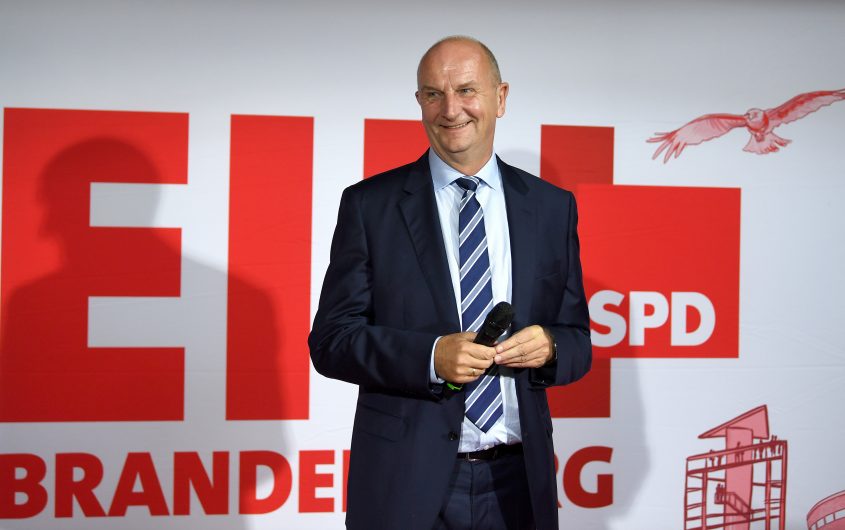
Monika Skolimowska/picture alliance via Getty Images
The Mainstream Strikes Back with Victories in Saxony and Brandenburg, but the AfD Is Not Going Away

Jeff Rathke
President of AGI
Jeffrey Rathke is the President of the American Institute for Contemporary German Studies at the Johns Hopkins University in Washington, DC.
Prior to joining AICGS, Jeff was a senior fellow and deputy director of the Europe Program at CSIS, where his work focused on transatlantic relations and U.S. security and defense policy. Jeff joined CSIS in 2015 from the State Department, after a 24-year career as a Foreign Service Officer, dedicated primarily to U.S. relations with Europe. He was director of the State Department Press Office from 2014 to 2015, briefing the State Department press corps and managing the Department's engagement with U.S. print and electronic media. Jeff led the political section of the U.S. Embassy in Kuala Lumpur from 2011 to 2014. Prior to that, he was deputy chief of staff to the NATO Secretary General in Brussels. He also served in Berlin as minister-counselor for political affairs (2006–2009), his second tour of duty in Germany. His Washington assignments have included deputy director of the Office of European Security and Political Affairs and duty officer in the White House Situation Room and State Department Operations Center.
Mr. Rathke was a Weinberg Fellow at Princeton University (2003–2004), winning the Master’s in Public Policy Prize. He also served at U.S. Embassies in Dublin, Moscow, and Riga, which he helped open after the collapse of the Soviet Union. Mr. Rathke has been awarded national honors by Estonia, Latvia, and Lithuania, as well as several State Department awards. He holds an M.P.P. degree from Princeton University and B.A. and B.S. degrees from Cornell University. He speaks German, Russian, and Latvian.
__
Voters in Brandenburg and Saxony today rendered judgments that reach well beyond the borders of two states that used to be part of the German Democratic Republic, as my colleague Eric Langenbacher recently described. Each state has been ruled uninterruptedly by one party since German unification: the Christian Democratic Union (CDU) in Saxony, and the Social Democratic Party (SPD) in Brandenburg. These two “Volksparteien” have been challenged in recent years by the rise of the far-right Alternative for Germany (AfD) and by a more general fragmentation and reordering of the political landscape. The AfD threatened to take first in both states, repeating its achievement in the May 2019 European Parliament elections. Uncertainty in the CDU and SPD about how to confront the AfD politically and roll back its gains has shaped much of German politics since the 2017 Bundestag elections. Against the backdrop of its continuously declining public support, the SPD in particular has reached a previously unthinkable level of desperation: significant voices have advocated an exit from Angela Merkel’s CDU-SPD government in order to redefine and strengthen the SPD message in opposition. Today’s result was a vindication of sorts for the CDU in Saxony and for the SPD in Brandenburg. Each finished first in their stronghold against the backdrop of dramatically increased voter participation, which should inject a measure of stability into national-level politics by demonstrating a new ability of the parties to defend their traditional territory. But forming effective governments in these states that can reconcile diverse parties will be a significant challenge.
Today’s result was a vindication of sorts for the CDU in Saxony and for the SPD in Brandenburg.
The result today affirms a new phase in German politics, characterized by two countervailing trends. On the one hand there is the grim reality of a firmly established AfD as one of the top vote-getters, finishing second in both states. On the other hand, there is a reenergized but nevertheless fractured set of democratically oriented parties that have succeeded for now in establishing a ceiling for the far right. This election casts in high relief a new challenge: Germany has traditionally been governed by two-party coalitions, but the fragmentation of the political spectrum in recent years increasingly requires three-party accommodations. Merkel sought to do so at the federal level in 2017 with the Greens and the liberal Free Democrats (FDP), but talks collapsed and a reluctant reboot of the Grand Coalition with the SPD was the only remaining option. Developing new alliances and tactics of government formation will require greater flexibility and policy compromise from parties even as they seek to sustain their core values and appeal to their voters.
This election casts in high relief a new challenge: Germany has traditionally been governed by two-party coalitions, but the fragmentation of the political spectrum in recent years increasingly requires three-party accommodations.
At the national level, Merkel’s CDU/CSU-SPD coalition will gain some breathing space for two reasons. The SPD will be able to point to Brandenburg minister-president Dietmar Woidke’s victory as evidence that the party retains the potential for broad appeal. It is true that to the south in Saxony, the SPD with just 8 percent of the vote suffered a historically bad outcome, but Brandenburg has always been a strength for the SPD in a way that Saxony never has. This should diminish the desperation among Social Democrats to seek renewed relevance in opposition, at least until the election of a new national party leadership at the end of October and a mid-term “review” of the Grand Coalition that the SPD party conference will vote on at the end of 2019. This increases the chances of Merkel remaining in office until the end of this legislative term in 2021.
Within the CDU, party chairperson Annegret Kramp-Karrenbauer will be strengthened by the strong result in Saxony, where the CDU historically has dominated but as recently as a few months ago seemed to risk losing to the AfD. Minister-President Michael Kretschmer conducted a vigorous campaign, but his success also comes as a relief to Kramp-Karrenbauer after the CDU’s poor result in May’s European Parliament elections. The risk of a near-term overt challenge to Kramp-Karrenbauer has decreased. But potential rivals—especially for the CDU’s nomination as its next chancellor candidate in elections that must happen by fall 2021—will remain keenly attentive for any sign of weak leadership or setbacks.
One of the most important results in today’s contests is the plateau in AfD support over the past two years.
One of the most important results in today’s contests is the plateau in AfD support over the past two years. Choosing one’s reference point is crucial. Some in recent days have focused on comparisons to the last elections in both states (2014) and painted a catastrophic canvas: the AfD in five years has gone from a marginal player to being within shouting distance of winning state elections. But the rise of the AfD has been observed, analyzed, and debated for half a decade; more telling is the leveling out of AfD support. In the 2017 Bundestag elections, the AfD reached 12 percent nationally and as high as 25 percent in some eastern states; the party repeated those levels in the 2019 European Parliament elections. They have been unable to expand their reach, suggesting that they have reached the limits of their appeal or that the retooling of the established parties to address voter grievances has capped the AfD’s potential for the time being.
Where does that leave the AfD? It is a firmly established feature in the landscape, but it is not in a position to govern, and all other parties have ruled out any formal or informal cooperation at the state or federal levels. It has become an obstacle to coalition formation but not a systemic threat to the democracy of the Federal Republic. Democratically oriented parties have shown the ability to fight and regain ground in this new era of politics.
Is the AfD the new “party of eastern Germany,” as some have dubbed it? The far-right party undoubtedly benefits from the frustrations of voters, especially in the east, who question the direction of German politics in an era of globalization and increasing international competition. Analysis by the German Institute for Economic Research, among others, has demonstrated that the principal locations of AfD support in the east are rural areas with negative demographic trends. Even voters in the east do not seem to see the AfD as “their” voice: a late August opinion poll in Brandenburg and Saxony showed that 40 percent and 35 percent, respectively, felt that “no party” best represents the east. Among those willing to name a party defending eastern interests, more chose the left-wing successor to the East German communist party, Die Linke. So one should discount heavily any short-handing of the far right as a true and exclusive voice of the east.
There were at least three other notable developments from today’s election:
- The left-wing Die Linke suffered major losses, sinking to a historic low of around 10 percent, which Bundestag caucus leader Dietmar Bartsch described as an “unparalleled disaster.”
- The Greens were major underperformers. They have been flying high in national polls (22-24 percent) in recent months and even challenged the CDU for first place in public opinion. Their results in Brandenburg and Saxony were several points less than expected, suggesting that their overall support may be inflated in the polls.
- The FDP failed to meet the 5 percent threshold for representation in Brandenburg or Saxony, a bitter blow despite some numerical gains since the last elections in each state. The FDP’s support across Germany has dwindled since it withdrew from coalition talks with Merkel in 2017 and today’s results will prompt soul-searching about the FDP’s direction.
Forming governing coalitions in Brandenburg and Saxony will be difficult, and political leaders will look now to the October 27 state elections in Thuringia to see whether the AfD can break through its ceiling in another eastern German state. But for the moment, Chancellor Merkel and her Social Democratic counterparts appear better positioned than many assumed just a few weeks ago.









